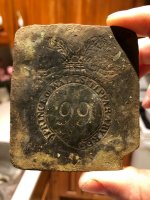Saving our sunken treasures: meeting on underwater cultural heritage
© UNESCO/E. Trainito Six years after its adoption by UNESCO in November 2001, the Convention on the Protection of the Underwater Cultural Heritage will be the theme of an information meeting on 23 November at Organization Headquarters. The event will bring together site managers and experts in underwater archaeology from all over the world to review current issues in this emerging discipline.
What are the latest discoveries in underwater heritage? What is happening with plans for underwater museums? What are the most recent developments in underwater archaeology? To answer these questions, 12 internationally renowned archaeologists are invited to the meeting, among them Ao Jie (China) who participated in the exploration of the Nanhai-1 shipwreck in Guangdong province, on the southern coast of China.
The ship, which went down during the Song dynasty (960-1279) in the Pearl River, at the departure point of the marine “Silk Road”, was excavated recently and will be exhibited in an aquarium museum scheduled for completion before December 2007. Ao Jie also helped investigate the Bailehang site, today at the bottom of the artificial lake of the Three Gorges Reservoir. The oldest known hydrological inscriptions are found there, recording 1200 years of water level variations. An underwater museum will soon open to allow access to this now-submerged site.
Another guest is Dr Alok Tripoathi (India), head archeologist of the Underwater Archaeology Wing of the Archaeological Survey of India. He participated notably in the explorations of Lakshadsweep, a peninsula on India’s southwestern coast, where ruins of the sunken city of Dwarka and the legendary Mahabalipuram temples were recently discovered.
Aiming to preserve submerged cultural property in situ and prevent looting by treasure hunters, the Convention on the Protection of the Underwater Cultural Heritage also promotes public access to this cultural heritage and encourages archaeological research. It does not arbitrate ownership issues nor call into question the sovereign rights of states. The Convention will enter into force three months after being ratified by 20 countries; it already has 16 States Parties.
A Press Conference will be held the day before the meeting, on 22 November at 11 a.m., with the archaeologists and Françoise Rivière, UNESCO’s Assistant Director-General for Culture. (UNESCO, 1 rue Miollis, 75015 Paris, Room XIV, level -2). Simultaneous interpretation in English and French will be provided.
*****
Journalists wishing to attend the press conference require accreditation from the Bureau of Public Information
Author(s):UNESCO Media Advisory No. 2007-77
Source:UNESCOPRESS
14-11-2007
© UNESCO/E. Trainito Six years after its adoption by UNESCO in November 2001, the Convention on the Protection of the Underwater Cultural Heritage will be the theme of an information meeting on 23 November at Organization Headquarters. The event will bring together site managers and experts in underwater archaeology from all over the world to review current issues in this emerging discipline.
What are the latest discoveries in underwater heritage? What is happening with plans for underwater museums? What are the most recent developments in underwater archaeology? To answer these questions, 12 internationally renowned archaeologists are invited to the meeting, among them Ao Jie (China) who participated in the exploration of the Nanhai-1 shipwreck in Guangdong province, on the southern coast of China.
The ship, which went down during the Song dynasty (960-1279) in the Pearl River, at the departure point of the marine “Silk Road”, was excavated recently and will be exhibited in an aquarium museum scheduled for completion before December 2007. Ao Jie also helped investigate the Bailehang site, today at the bottom of the artificial lake of the Three Gorges Reservoir. The oldest known hydrological inscriptions are found there, recording 1200 years of water level variations. An underwater museum will soon open to allow access to this now-submerged site.
Another guest is Dr Alok Tripoathi (India), head archeologist of the Underwater Archaeology Wing of the Archaeological Survey of India. He participated notably in the explorations of Lakshadsweep, a peninsula on India’s southwestern coast, where ruins of the sunken city of Dwarka and the legendary Mahabalipuram temples were recently discovered.
Aiming to preserve submerged cultural property in situ and prevent looting by treasure hunters, the Convention on the Protection of the Underwater Cultural Heritage also promotes public access to this cultural heritage and encourages archaeological research. It does not arbitrate ownership issues nor call into question the sovereign rights of states. The Convention will enter into force three months after being ratified by 20 countries; it already has 16 States Parties.
A Press Conference will be held the day before the meeting, on 22 November at 11 a.m., with the archaeologists and Françoise Rivière, UNESCO’s Assistant Director-General for Culture. (UNESCO, 1 rue Miollis, 75015 Paris, Room XIV, level -2). Simultaneous interpretation in English and French will be provided.
*****
Journalists wishing to attend the press conference require accreditation from the Bureau of Public Information
Author(s):UNESCO Media Advisory No. 2007-77
Source:UNESCOPRESS
14-11-2007








